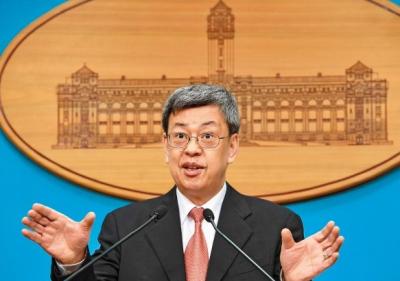Taiwan must increase its defense spending as a percentage of its GDP beyond that already recently pledged by President William Lai (賴清德) to demonstrate to foreign states willing to offer support that Taipei is taking the threat against it seriously, an article by Council of Foreign Relations fellow for Asia studies David Sacks said on Friday.
Sacks was referring to Lai’s comments on Tuesday, stating that the nation’s defense spending budget for next year would be an estimated NT$647 billion (US$19.94 billion), which is an increase of 6 percent from this year’s defense spending.
However, in the eyes of most foreign observers, such an increase still showed that “Taiwan is still not taking the existential threat that it faces seriously enough,” Sacks said.

Photo: Ministry of National Defense/AFP
The only metric most observers use is the percentage of a nation’s GDP that it allocates for defense spending, he added
Nearly 20 years after former president Chen Shui-bian (陳水扁) pledged to increase Taiwan’s defense spending to three percent of GDP in 2007, the nation has yet to meet that target, Sacks said.
Taiwan’s defense spending falls behind countries in a similar situation, Sacks said, citing Israel’s 2022 defense spending, which was 4.5 percent of its GDP, as an example.
“On the current trajectory, Taiwan risks falling further behind the PLA,” Sacks said in the article.
China’s higher defense spending baseline would mean that the gap between Taiwan’s and China’s military spending would only increase further, he added.
Sacks said that Taiwan’s defense spending is equivalent to roughly 2.5 percent of GDP, exceeding the baseline set for NATO members.
However, Tsai was unable to “lead a cultural shift within Taiwan’s Ministry of National Defense (MND), which is known for its conservatism, its attachment to legacy platforms such as fighter jets and large surface warships, and its skepticism toward adopting an asymmetric approach to defense,” Sacks said.
Lai’s appointment of Wellington Koo (顧立雄), the nation’s third civilian defense minister, demonstrates his understanding that the MND must undergo a shakeup, he said.
The urgently needed increase in Taiwan’s defense spending should go toward creating more incentives to attract civilians to join the military after officially transitioning from a conscription-based military to an all-volunteer force, as well as covering the costs of the increased scrambling of jets and deploying of ships in response to PLA naval exercises, he said.
Sacks added that the development and production of drones, uncrewed systems and stockpiling munitions as part of an asymmetric strategy, and producing additional hulls to make its significant upfront investment in its indigenous submarine program pay off, would also benefit from higher defense spending budgets.

Several Chinese Nationalist Party (KMT) officials including Chairman Eric Chu (朱立倫) are to be summoned for questioning and then transferred to prosecutors for holding an illegal assembly in Taipei last night, the Taipei Police said today. Chu and two others hosted an illegal assembly and are to be requested to explain their actions, the Taipei City Police Department's Zhongzheng (中正) First Precinct said, referring to a protest held after Huang Lu Chin-ju (黃呂錦茹), KMT Taipei's chapter director, and several other KMT staffers were questioned for alleged signature forgery in recall petitions against Democratic Progressive Party (DPP) legislators. Taipei prosecutors had filed

Taiwan would welcome the return of Honduras as a diplomatic ally if its next president decides to make such a move, Minister of Foreign Affairs Lin Chia-lung (林佳龍) said yesterday. “Of course, we would welcome Honduras if they want to restore diplomatic ties with Taiwan after their elections,” Lin said at a meeting of the legislature’s Foreign Affairs and National Defense Committee, when asked to comment on statements made by two of the three Honduran presidential candidates during the presidential campaign in the Central American country. Taiwan is paying close attention to the region as a whole in the wake of a

President William Lai (賴清德) has appointed former vice president Chen Chien-jen (陳建仁) to attend the late Pope Francis’ funeral at the Vatican City on Saturday on his behalf, the Ministry of Foreign Affairs said today. The Holy See announced Francis’ funeral would take place on Saturday at 10am in St Peter’s Square. The ministry expressed condolences over Francis’ passing and said that Chen would represent Taiwan at the funeral and offer condolences in person. Taiwan and the Vatican have a long-standing and close diplomatic relationship, the ministry said. Both sides agreed to have Chen represent Taiwan at the funeral, given his Catholic identity and

NEW WORLD: Taiwan is pursuing innovative approaches to international relations through economics, trade and values-based diplomacy, the foreign minister said Taiwan would implement a “three-chain strategy” that promotes democratic values in response to US tariffs, Minister of Foreign Affairs Lin Chia-lung (林佳龍) said. Taiwan would aim to create a “global democratic value chain,” seek to capitalize on its position within the first island chain and promote a “non-red supply chain,” Lin was quoted as saying in the ministry’s written report to the Legislative Yuan submitted ahead of the legislature’s Foreign Affairs and National Defense Committee meeting slated for today. The Ministry would also uphold a spirit of mutual beneficial collaboration, maintaining close communication and consultations with Washington to show that Taiwan-US cooperation